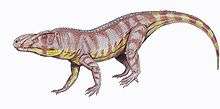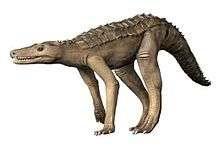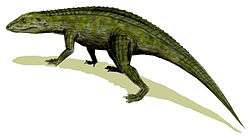Luperosuchus
| Luperosuchus | |
|---|---|
 | |
| Life restoration of Luperosuchus fractus | |
| Scientific classification | |
| Kingdom: | Animalia |
| Phylum: | Chordata |
| Class: | Reptilia |
| Clade: | Loricata |
| Genus: | †Luperosuchus Romer, 1971 |
| Type species | |
| Luperosuchus fractus Romer, 1971 | |
Luperosuchus (meaning "vexing" or "difficult crocodile") is an extinct genus of large "rauisuchian" pseudosuchian. It lived between the Ladinian stage of the late Middle Triassic to the earliest Carnian of the Late Triassic, and is known from the Chañares Formation of Argentina. It contains only a single type species, Luperosuchus fractus.
Description
Luperosuchus is known only from a single incomplete skull, with an associated atlas intercentrum representing the only known postcranial material.[1] However, it is likely that it was a large quadruped, similar to other basal loricatans. Isolated osteoderms from the same region were initially attributed this genus based on their size and similarity to those of other "rauisuchian" osteoderms,[2] however they were later found to be belong to the contemporary doswelliid Tarjadia.[3] The presence of osteoderms in Luperosuchus is therefore left ambiguous. The length has been estimated to be 4.1-4.4 meters (13.5-14.4 ft) based on rauisuchids and 3.7 meters (12.3 ft) based on Prestosuchus.
Skull
The skull belongs to a large animal, with the preserved portions measuring 54.5 centimetres (21.5 in) and an estimated complete length of approximately 60 centimetres (2.0 ft), resembling those of other basal loricatans. The material largely consists of the skull roof, including the nasals, maxilla and part of the premaxilla. The snout is narrow and pointed, with a tall maxilla featuring a triangular antorbital fenestra. The premaxilla has a long posterodorsally directed process that articulates with the nasals, excluding the maxilla from the external naris, which tapers posteriorly. The orbit is tall and described as 'key-hole shaped', with the infratemporal fenestra exhibiting a similar size and shape. A narrow slit was identified between the premaxilla and maxilla, as in other loricatans, however this feature is likely to be from postmortem distortion rather than anatomical.[1] An unusual feature found in Luperosuchus is the tall, mediolaterally compressed crest that sits on the front of the snout. This structure is formed by the dorsally arching nasals, and has been described as a 'roman-nose' following Romer's initial description. A similar structure is found in other loricatans, particularly Prestosuchus and Saurosuchus, although it is most prevalent in Luperosuchus.[2][1]
Discovery and naming
The holotype material of Luperosuchus, specimen PULR 04, was collected by Ruth Romer, wife of palaeontologist Alfred S. Romer, on January 17, 1965.[4] It was found near the remains of a large dicynodont at a locality about 5 km northeast of where the Chañares River emerges onto the Plano de Talampaya. The site is believed to represent the top of the lower member of the Chañares Formation, based on similarities in preservation and the composition of the surrounding matrix to other fossils known from this time interval. This would be positioned below the strata recently dated by Marsicano et al.,[5] providing a minimum age of 236.1 +/- 0.6 Ma for the Luperosuchus locality. The material is stored at the La Plata Museum in La Plata, Argentina.[1]
Romer published his description of Luperosuchus in 1971, as part of a series of articles describing the numerous "thecodonts" he had collected from the Chañares Formation. The binomial name, Luperosuchus fractus, refers to the fragmentary and "perplexing" nature of the fossil, and is derived from the Greek lyperos ("vexing", "difficult", "troublesome") and souchos ("crocodile"), with the specific name is from the Latin fractus, meaning "broken".[2]
Romer had collected additional fragments of bone from the holotype locality, but was unsure if they belonged to Luperosuchus or the dicynodont collected with it. After rediscovering and examining these fragments, Nesbitt & Desojo determined that many of the identifiable pieces were consistent with loricatan archosaurs, and so referred them to the holotype of Luperosuchus. These additional pieces include portions of the maxilla, quadrate, fragments of the braincase and the atlas intercentrum, the only postcranial material for Luperosuchus.[1]
A second specimen, PULR 057, was reported in 2009 by Desojo & Arcucci and was referred to this genus. This specimen however was a third smaller than the type specimen, and differed from it in a number of aspects, including a less developed 'roman-nose', but these were interpreted as ontogenetic variation as the material appeared to exhibit juvenile features (including loose sutures and less developed ornamentation of the bones).[6] The referral of this material to Luperosuchus was questioned by Nesbitt & Desojo in 2017, and suggested that the differences are taxonomic, rather than ontogenetic. The holotype PULR 04 remains the only known material of Luperosuchus, with the taxonomic identity of the former referred specimen PULR 057 currently unknown.[1]
Classification
Romer identified Luperosuchus as a member of the family Rauisuchidae in 1971, however at the time of his description the relationships of Rauisuchidae to other archosaurs were poorly understood and a detailed examination of its relationships was not performed. Luperosuchus was largely ignored in later phylogenetic analyses of Triassic pseudosuchians, likely due to the poor preservation of its remains and lack of identifying characteristics, as well as an unclear understanding of the interelationships of close relatives.[1] As such, it was typically only ever provisionally assigned to "Rauisuchia" based on general similarities, without further justification.
Luperosuchus was incorporated into a phylogenetic analysis for the first time by Nesbitt & Desojo in 2017, where it was recovered in a clade with two other South American loricatans, Saurosuchus and Prestosuchus, at the base of Loricata.[1] They found two equally plausible hypotheses for the least inclusive position of Luperosuchus; one as a sister taxon to both Saurosuchus and Prestosuchus, and another as a sister taxon to Saurosuchus, the former of which is reproduced here:
| Archosauria |
| ||||||||||||||||||||||||||||||||||||||||||||||||||||||||||||||||||||||||
Palaeobiology
Histology and growth
The skull of Luperosuchus has very few visible sutures, partly due to the material's poor preservation but also from the addition of consolidates to the surface of the specimen that obscure finer anatomical details.[1] Romer struggled to identify the suture pattern, but identified fused sutures which he interpreted as a possible indicator that the specimen was mature.[2] Later examination by Nesbitt & Desojo confirmed that many of the sutures in the skull of Luperosuchus were obliterated, with the bones in the skull fully fused, in addition to well developed sculpting of the bones.[1]
In 2008, Ricqlès et al. reported that they performed a histological study on a limb bone belonging to Luperosuchus, identified as specimen MCZ 4077.[7] However, as Luperosuchus is only definitively known from the holotype material, it is unclear what Ricqlès et al. had sectioned, and the growth patterns of Luperosuchus remain unknown.[1]
Palaeoecology
Luperosuchus is one of the largest animals in the Chañares Formation, and indeed was one of the few large animals known from the formation. In the lower member of the formation, it shared its environment with smaller archosauromorphs, including proterochampsians, the doswelliid Tarjadia, and the archosaur taxon represented by PULR 057, possibly a related loricatan. A specimen of a large paracrocodylomorph has been reported from the Chañares, possibly representing the largest predatory archosaur in the ecosystem. Luperosuchus also coexisted with several therapsids, including the very abundant dicynodont Dinodontosaurus, as well as numerous cynodonts such as Massetognathus. The environment of the Chañares Formation is characterised by deposits of pyroclastic and volcaniclastic materials, such as tuff and ash, indicating a complex history of regional volcanism in the environment.
References
- 1 2 3 4 5 6 7 8 9 10 11 Sterling J. Nesbitt; Julia B. Desojo (2017). "The Osteology and Phylogenetic Position of Luperosuchus fractus (Archosauria: Loricata) from the Latest Middle Triassic or Earliest Late Triassic of Argentina". Ameghiniana. 54 (3): 261–282. doi:10.5710/AMGH.09.04.2017.3059.
- 1 2 3 4 A. S. Romer (1971c). "The Chañares (Argentina) Triassic reptile fauna. VIII. A fragmentary skull of a large thecodont, Luperosuchus fractus". Breviora. 373: 1–8.
- ↑ Arcucci, A.; Marsicano, C.A. (1998). "A distinctive new archosaur from the Middle Triassic (Los Chañares Formation) of Argentina". Journal of Vertebrate Paleontology. 18 (1): 228–232. doi:10.1080/02724634.1998.10011046.
- ↑ Jensen, J. A. (2001). The Road to Chilecito. Launceston, Tasmania: Queen Victoria Museum and Art Gallery. p. 184. ISBN 978-0-9586203-5-2. OCLC 49797079.
- ↑ Claudia A. Marsicano; Randall B. Irmis; Adriana C. Mancuso; Roland Mundil; Farid Chemale (2016). "The precise temporal calibration of dinosaur origins". Proceedings of the National Academy of Sciences of the United States of America. 113 (3): 509–513. doi:10.1073/pnas.1512541112. PMC 4725541. PMID 26644579.
- ↑ Desojo, J.B.; Arcucci, A.B. (2009). "New material of Luperosuchus fractus (Archosauria: Crurotarsi) from the Middle Triassic of Argentina: the earliest known South American "rauisuchian"". Journal of Vertebrate Paleontology. 29 (4): 1311–1315. doi:10.1671/039.029.0422.
- ↑ Ricqlès, A. de.; Padian, K.; Knoll, F.; Horner, J.R. (2008). "On the origin of rapid growth rates in archosaurs and their ancient relatives: complementary histological studies on Triassic archosauriforms and the problem of a "phylogenetic signal" in bone histology". Annales de Paleontologie. 94 (2): 57–76. doi:10.1016/j.annpal.2008.03.002.


